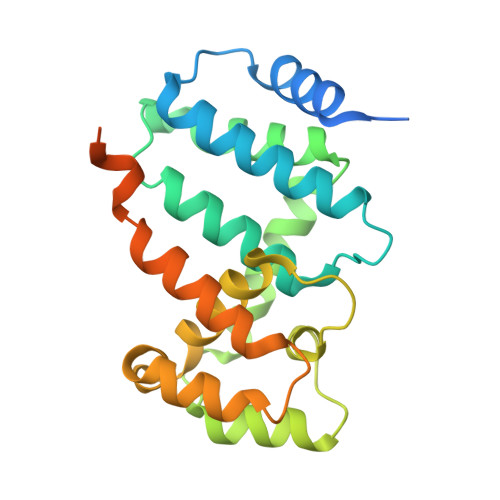Structure of Psb29/Thf1 and its association with the FtsH protease complex involved in photosystem II repair in cyanobacteria.
Bec Kova, M., Yu, J., Krynicka, V., Kozlo, A., Shao, S., Konik, P., Komenda, J., Murray, J.W., Nixon, P.J.(2017) Philos Trans R Soc Lond B Biol Sci 372
- PubMed: 28808107
- DOI: https://doi.org/10.1098/rstb.2016.0394
- Primary Citation of Related Structures:
5MJO, 5MJR, 5MJW, 5MLF - PubMed Abstract:
One strategy for enhancing photosynthesis in crop plants is to improve their ability to repair photosystem II (PSII) in response to irreversible damage by light. Despite the pivotal role of thylakoid-embedded FtsH protease complexes in the selective degradation of PSII subunits during repair, little is known about the factors involved in regulating FtsH expression. Here we show using the cyanobacterium Synechocystis sp. PCC 6803 that the Psb29 subunit, originally identified as a minor component of His-tagged PSII preparations, physically interacts with FtsH complexes in vivo and is required for normal accumulation of the FtsH2/FtsH3 hetero-oligomeric complex involved in PSII repair. We show using X-ray crystallography that Psb29 from Thermosynechococcus elongatus has a unique fold consisting of a helical bundle and an extended C-terminal helix and contains a highly conserved region that might be involved in binding to FtsH. A similar interaction is likely to occur in Arabidopsis chloroplasts between the Psb29 homologue, termed THF1, and the FTSH2/FTSH5 complex. The direct involvement of Psb29/THF1 in FtsH accumulation helps explain why THF1 is a target during the hypersensitive response in plants induced by pathogen infection. Downregulating FtsH function and the PSII repair cycle via THF1 would contribute to the production of reactive oxygen species, the loss of chloroplast function and cell death.This article is part of the themed issue 'Enhancing photosynthesis in crop plants: targets for improvement'.
- Institute of Microbiology, Center Algatech, Opatovický mlýn, 37981 Třeboň, Czech Republic.
Organizational Affiliation:

















